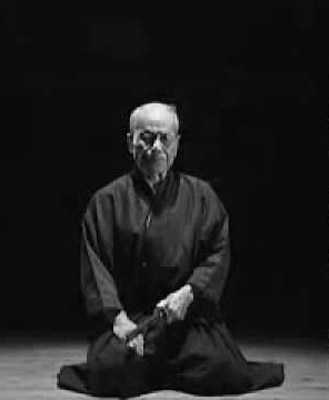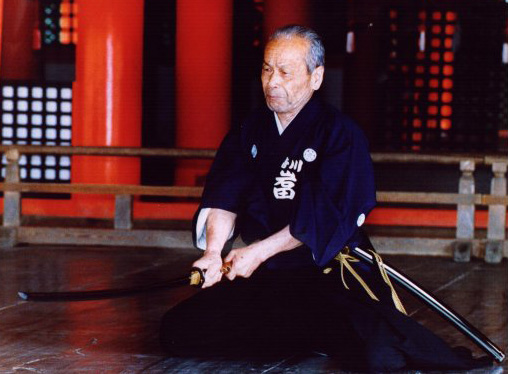
Iaido and Muso Jikiden Eishin Ryu by one of Japan’s most respected Iaido teachers, Iwata Norikazu Hanshi.
This photograph was taken a a special ceremony when a Budo Shrine was opened. This cannot or should I say should not be seen elsewhere as no one else has had a chance to take this picture. He was a retainer of the Mogami clan Oshu in Ashikaga Era (1336-1576). Oshu is the current-day Yamagata Prefecture in northern Honshu. During the Eiroku Era (1558–69) the school of fencing came to be known as the Ayah School, or the Shigenobu School. Nearly two centuries later during the Kyoho Era (1716–36), Shuze Hasegawa, a swordsman of unprecedented prowess, fused his unique technique into the art, and changed the name of the school to the Musojikiden Shigenobu School. He established a following in his native district of Tosa in Kochi Prefecture in Shikoku). What remains are mostly Ha or different branches and offshoots of original Ryu practising a variation of the original style. Also some Seitei Iaido practitioners have mixed their basics to produce an unbelievable mishmash of movements. One can join a Japanese Iaido Dojo to find that no one actually does Koryu. After all who needs it to pass Dan Grades? There are many Japanese and Western Iaidoka aware of this problem and are keen to differentiate between technique and basics. In reading this book one can begin to separate many of the facets. Nowadays a lot of the Japanese Sensei who can clearly separate Iaido, Iai-Jutsu, Batto-Jutsu are in their eighties. Another ten years or so will see an even more rapid decline in the knowledge of the sword unless we take advantage and learn from their teachings. One only has to pick up Kendo Nippon or Kendo Jidai magazines to see that one of the senior most respected Sensei of the Ryu is Iwata Norikazu Hanshi, holder of two Menkyo Kaiden and a Iaido Hanshi. Born in 1913 in Kochi. He studied under the students of Oh-e Masamichi. Fukui Harumasa, Suzue Yoshishige, Takaoka Den. At University he continued his studies under Mori Shigeki Sensei. He was given generous instruction by Yamamoto Takuji from August 1957 for a period of twenty years. He has written two books on Iaido, and is featured monthly in Kendo Nippon. His tuition and writings are superb as he relates to us his teachers guidance and that of Oh-e Masamichi (Roshu) the founder of Muso Jikiden Eishin Ryu. ALL OF HIS TECHNIQUES ARE ORTHODOX According to the explanation of my teacher Yamamoto Takuji; Master Oh-e studied Eishin Ryu Shimomura Ha and became the 15th Headmaster. Although he left that school and joined the Tanimura Ha and took over as the 17th Headmaster. No one knows his actual reason for doing this. Nevertheless I would like to put forward my own opinions. Master Oh-e was a Kendo instructor. Therefore the Iai posture was comparable - Facing straight forward. I think this was his primary posture. DIFFERENTIATION BETWEEN JIKIDEN AND SHIMOMURA HA a) The Shimomura Ha has more hand and finger techniques compared to Tanimura Ha. b) This style permits more body twisting movements than Jikiden. c) The twisting of the body and the timing of Noto + footwork activity is more assiduous than Jikiden and is very technical. Because of these reasons the method of Oh-e Sensei, Face to Face became more popular with students who had originally started with Kendo. The fundamental standing posture in Kendo (Chudan no Kamae) is to keep the head and shoulders square on. (Not to be confused with modern day Kendo with the body and both feet facing forward). I believe that the basic methods of Oh-e were based on this. Master Oh-e also experienced real battle (a political war at Hamaguri Gomon) The Clam Gate War in Kyoto at the end of the Tokugawa era. This is why his technique seemed so realistic.
Read |



